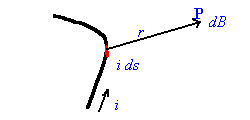

 |
|
How to verify Biot-Savart Law ?
The magnetic of dB is inversely proportional to r2 , where r is the distance from the element to the point P. However, the current must form a loop. You will not have only a small current element. All the current elements along the current loop can contribute to the magnetic field at point P. How do we measure magnetic field dB just due to a small current element? Here is an ideal!
There is no magnetic field in the direction of the current element. The above two green lines meet at blue dot P. Current elements from green lines will not produce magnetic field at point P. The magnetic field at point P is due to current elements from two yellow line sections. We can keep one of the current element much further away from point P. Now we have a way to measure the magnetic field just due to one current element.
Why is that ? Is there something wrong with the program? Look at tires of a car when it is accelerating! Those tires seem to be rotated faster and then change direction ...! Your suggestions are highly appreciated! Please click hwang@phy03.phy.ntnu.edu.tw
Author:Fu-Kwun Hwang, Dept. of physics, National Taiwan Normal University Last modified : More physics related java applets
|

